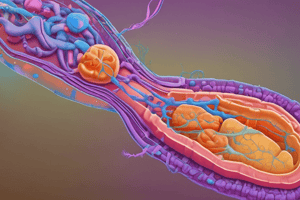Podcast
Questions and Answers
Name the enzymes secreted by the pancreas and describe their biochemical action
Name the enzymes secreted by the pancreas and describe their biochemical action
Pancreatic enzymes, such as amylase, lipase, and protease, break down carbohydrates, fats, and proteins respectively.
State the mechanisms that prevent autodigestion by pancreatic enzymes
State the mechanisms that prevent autodigestion by pancreatic enzymes
The pancreas produces inactive enzymes that are activated in the small intestine, preventing self-digestion.
Describe the neural and endocrine mechanisms which control pancreatic exocrine secretion during the course of a meal
Describe the neural and endocrine mechanisms which control pancreatic exocrine secretion during the course of a meal
Neural mechanisms, such as vagal stimulation, and hormonal mechanisms, such as the release of cholecystokinin, regulate pancreatic enzyme secretion during digestion.
GI tract is a hollow tube extending from mouth to ______
GI tract is a hollow tube extending from mouth to ______
Absorption in GI Tract: PART 1: PANCREATIC SECRETIONS (EXOCRINE FUNCTION) Describe the path of pancreatic juices into the ______.
Absorption in GI Tract: PART 1: PANCREATIC SECRETIONS (EXOCRINE FUNCTION) Describe the path of pancreatic juices into the ______.
Flashcards are hidden until you start studying
Study Notes
Pancreatic Enzymes
- Pancreatic amylase: breaks down starch into maltose
- Trypsin: breaks down proteins into smaller peptides
- Chymotrypsin: breaks down proteins into smaller peptides
- Carboxypeptidase: breaks down proteins into amino acids
- Lipase: breaks down fats into fatty acids and glycerol
Mechanisms Preventing Autodigestion
- Pancreatic enzymes are secreted in inactive forms:
- Trypsinogen (inactive form of trypsin)
- Chymotrypsinogen (inactive form of chymotrypsin)
- Procarboxypeptidase (inactive form of carboxypeptidase)
- Activation of enzymes occurs in the small intestine:
- Enterokinase, an enzyme present in the small intestine, activates trypsinogen to trypsin
- Trypsin then activates other pancreatic enzymes, such as chymotrypsinogen and procarboxypeptidase
- Inhibitory proteins:
- Pancreatic trypsin inhibitor (PTI), a protein present in pancreatic juice, can block the activity of trypsin, preventing premature activation of enzymes within the pancreas itself.
Neural and Endocrine Control of Pancreatic Exocrine Secretion
- Neural control:
- Parasympathetic stimulation (via the vagus nerve) increases pancreatic secretion
- This is mediated by acetylcholine, which stimulates the release of pancreatic enzymes and bicarbonate
- Endocrine control:
- Cholecystokinin (CCK) is released from the duodenum in response to the presence of fats and proteins. It stimulates the release of pancreatic enzymes.
- Secretin is released from the duodenum in response to the presence of acid in the duodenum. It stimulates the release of bicarbonate from the pancreas, which helps neutralize the acid.
Pathway of Pancreatic Juices
- The path of pancreatic juices into the small intestine is as follows:
- Pancreatic secretions flow from the pancreas, through the pancreatic duct, into the common bile duct.
- From there, they enter the duodenum, the first part of the small intestine.
GI Tract
- The GI tract is a hollow tube extending from the mouth to the anus.
Studying That Suits You
Use AI to generate personalized quizzes and flashcards to suit your learning preferences.




